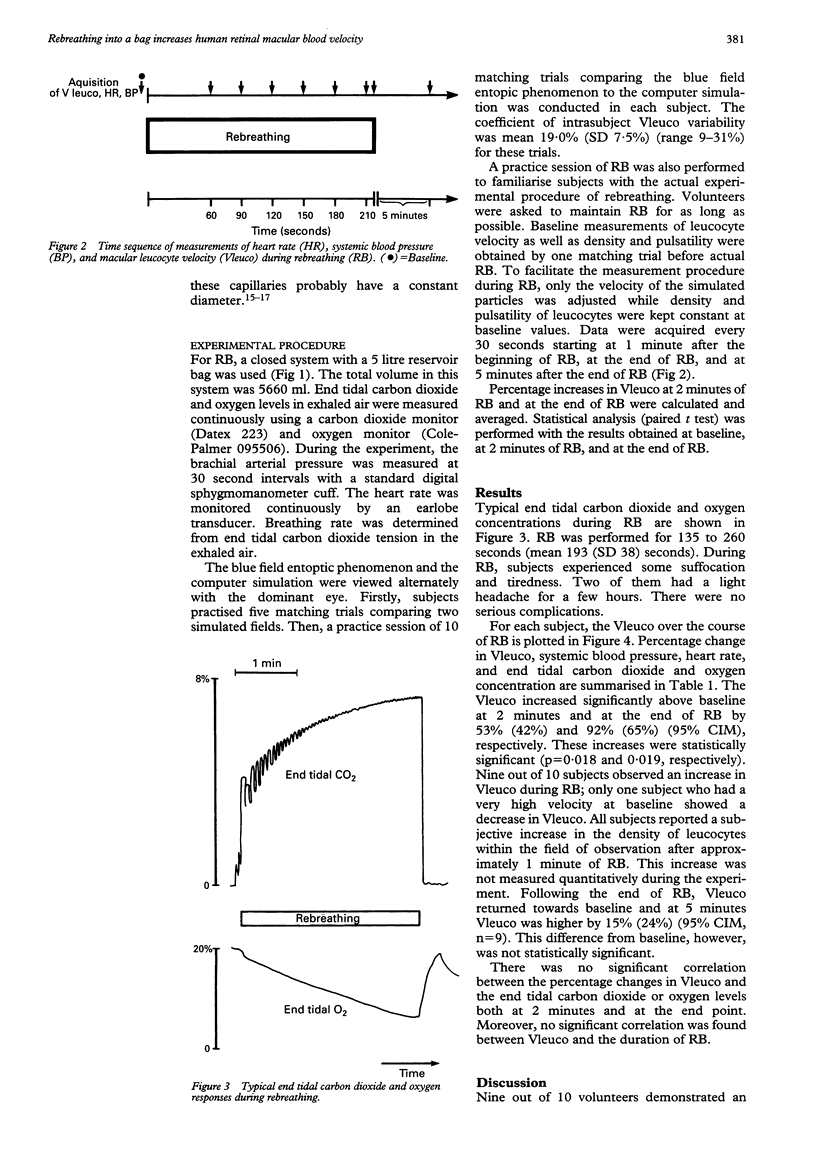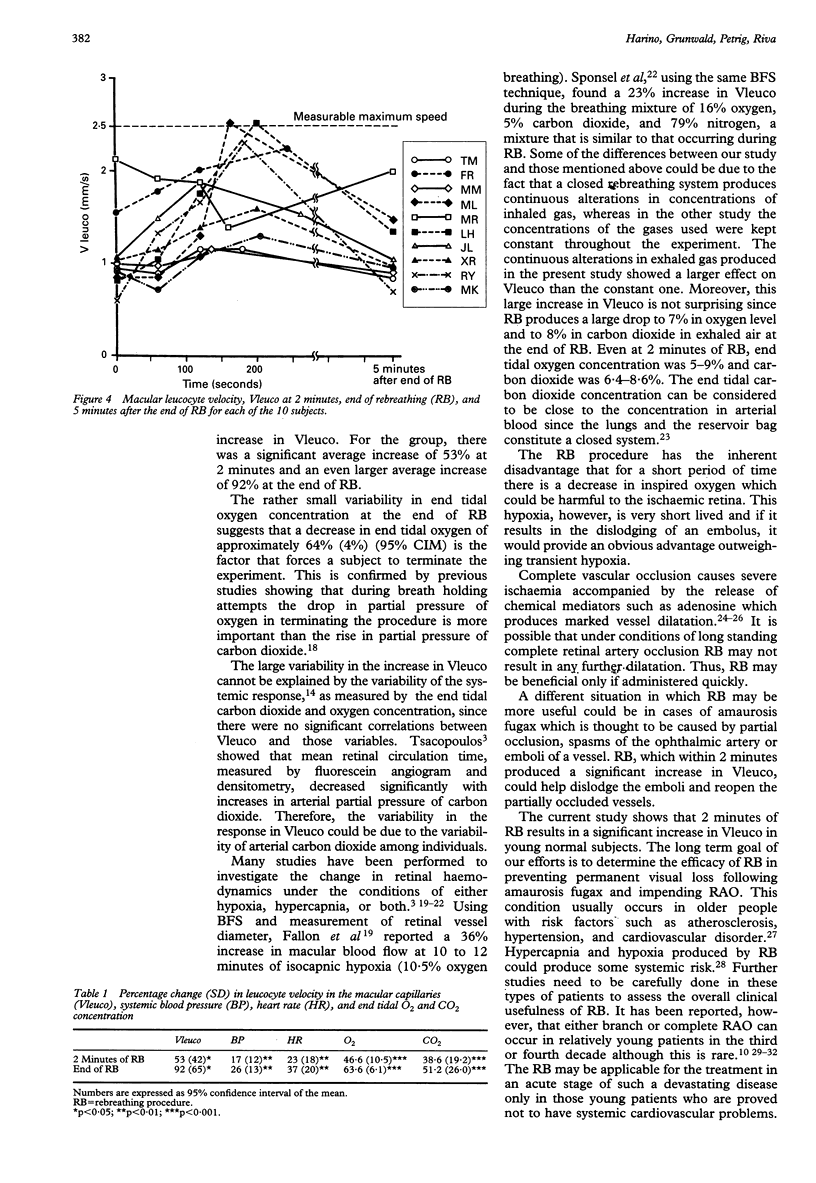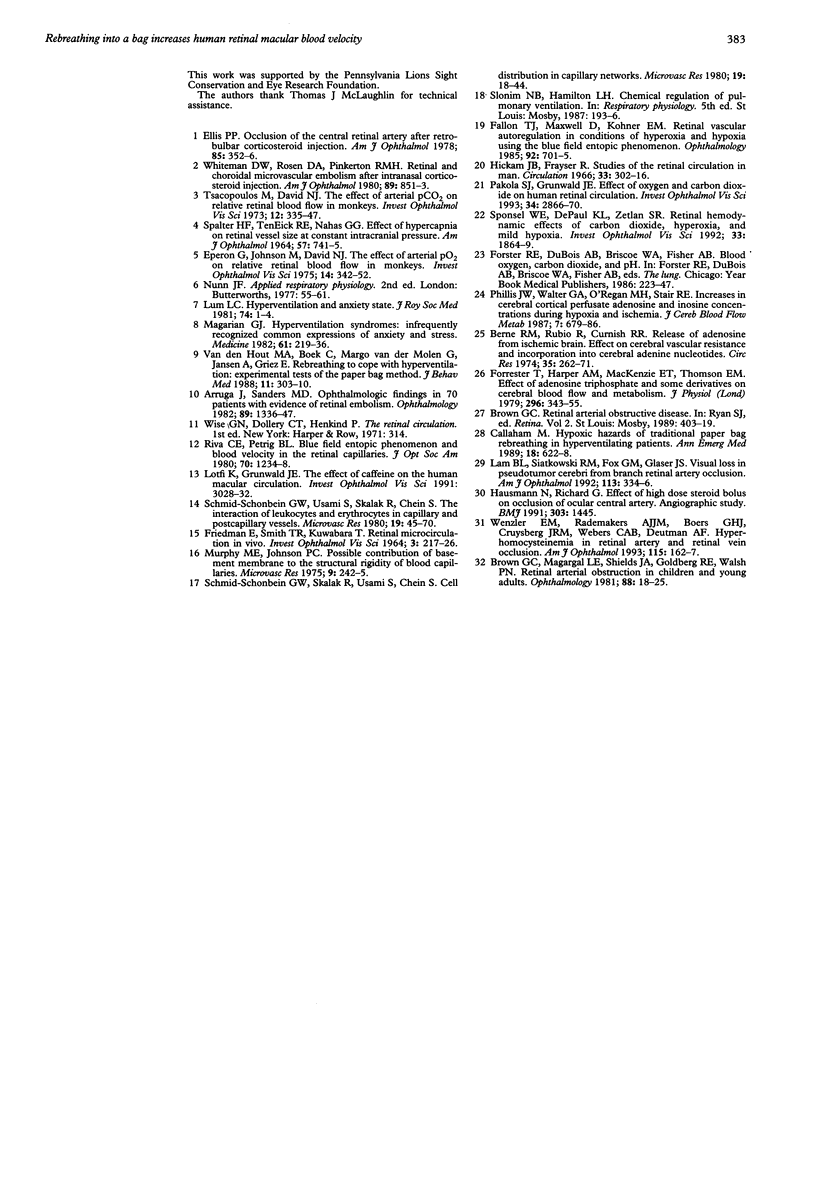Abstract
AIMS--The effect of rebreathing into a bag (RB) on retinal macular blood velocity was evaluated in healthy volunteers. METHODS--Ten normal volunteers, whose ages ranged from 17 to 34 years, performed RB over 135 to 260 seconds (mean (SD) 193 (38) seconds) while retinal macular blood velocity was determined non-invasively using the blue field simulation technique. RESULTS--Leucocyte velocity significantly increased (p < 0.05) at 2 minutes and at the end of RB by 53% (42%) and 92% (65%), respectively (95% confidence interval of the mean (CIM)). All subjects observed an increase in the density of leucocytes. At the end of RB, mean systolic brachial arterial pressure and heart rate were significantly increased by 24% (11%) and 37% (15%) respectively (p < 0.01). At 2 minutes, end tidal oxygen concentration in the exhaled air was 47% (8%) (95% CIM) below and carbon dioxide was 41% (16%) above baseline (p < 0.001). The RB produces a large increase in macular leucocyte velocity, suggesting an increase in blood flow. CONCLUSION--Although RB has some systemic risk due to hypoxia and hypercapnia, RB for a short period of 1 or 2 minutes might be of help in the treatment of retinal arterial obstructive diseases in young patients without cardiovascular disorders if other treatments do not show any beneficial effects.
Full text
PDF



Selected References
These references are in PubMed. This may not be the complete list of references from this article.
- Arruga J., Sanders M. D. Ophthalmologic findings in 70 patients with evidence of retinal embolism. Ophthalmology. 1982 Dec;89(12):1336–1347. doi: 10.1016/s0161-6420(82)34626-6. [DOI] [PubMed] [Google Scholar]
- Brown G. C., Magargal L. E., Shields J. A., Goldberg R. E., Walsh P. N. Retinal arterial obstruction in children and young adults. Ophthalmology. 1981 Jan;88(1):18–25. doi: 10.1016/s0161-6420(81)35080-5. [DOI] [PubMed] [Google Scholar]
- Callaham M. Hypoxic hazards of traditional paper bag rebreathing in hyperventilating patients. Ann Emerg Med. 1989 Jun;18(6):622–628. doi: 10.1016/s0196-0644(89)80515-3. [DOI] [PubMed] [Google Scholar]
- Ellis P. P. Occlusion of the central retinal artery after retrobulbar corticosteroid injection. Am J Ophthalmol. 1978 Mar;85(3):352–356. doi: 10.1016/s0002-9394(14)77728-1. [DOI] [PubMed] [Google Scholar]
- Eperon G., Johnson M., David N. J. The effect of arterial PO2 on relative retinal blood flow in monkeys. Invest Ophthalmol. 1975 May;14(5):342–352. [PubMed] [Google Scholar]
- FRIEDMAN E., SMITH T. R., KUWABARA T. RETINAL MICROCIRCULATION IN VIVO. Invest Ophthalmol. 1964 Apr;3:217–226. [PubMed] [Google Scholar]
- Fallon T. J., Maxwell D., Kohner E. M. Retinal vascular autoregulation in conditions of hyperoxia and hypoxia using the blue field entoptic phenomenon. Ophthalmology. 1985 May;92(5):701–705. doi: 10.1016/s0161-6420(85)33978-7. [DOI] [PubMed] [Google Scholar]
- Forrester T., Harper A. M., MacKenzie E. T., Thomson E. M. Effect of adenosine triphosphate and some derivatives on cerebral blood flow and metabolism. J Physiol. 1979 Nov;296:343–355. doi: 10.1113/jphysiol.1979.sp013009. [DOI] [PMC free article] [PubMed] [Google Scholar]
- Hausmann N., Richard G. Effect of high dose steroid bolus on occlusion of ocular central artery: angiographic study. BMJ. 1991 Dec 7;303(6815):1445–1446. doi: 10.1136/bmj.303.6815.1445. [DOI] [PMC free article] [PubMed] [Google Scholar]
- Lam B. L., Siatkowski R. M., Fox G. M., Glaser J. S. Visual loss in pseudotumor cerebri from branch retinal artery occlusion. Am J Ophthalmol. 1992 Mar 15;113(3):334–336. doi: 10.1016/s0002-9394(14)71590-9. [DOI] [PubMed] [Google Scholar]
- Lotfi K., Grunwald J. E. The effect of caffeine on the human macular circulation. Invest Ophthalmol Vis Sci. 1991 Nov;32(12):3028–3032. [PubMed] [Google Scholar]
- Lum L. C. Hyperventilation and anxiety state. J R Soc Med. 1981 Jan;74(1):1–4. doi: 10.1177/014107688107400101. [DOI] [PMC free article] [PubMed] [Google Scholar]
- Magarian G. J. Hyperventilation syndromes: infrequently recognized common expressions of anxiety and stress. Medicine (Baltimore) 1982 Jul;61(4):219–236. [PubMed] [Google Scholar]
- Murphy M. E., Johnson P. C. Possible contribution of basement membrane to the structural rigidity of blood capillaries. Microvasc Res. 1975 Mar;9(2):242–245. doi: 10.1016/0026-2862(75)90084-9. [DOI] [PubMed] [Google Scholar]
- Pakola S. J., Grunwald J. E. Effects of oxygen and carbon dioxide on human retinal circulation. Invest Ophthalmol Vis Sci. 1993 Sep;34(10):2866–2870. [PubMed] [Google Scholar]
- Phillis J. W., Walter G. A., O'Regan M. H., Stair R. E. Increases in cerebral cortical perfusate adenosine and inosine concentrations during hypoxia and ischemia. J Cereb Blood Flow Metab. 1987 Dec;7(6):679–686. doi: 10.1038/jcbfm.1987.122. [DOI] [PubMed] [Google Scholar]
- Riva C. E., Petrig B. Blue field entoptic phenomenon and blood velocity in the retinal capillaries. J Opt Soc Am. 1980 Oct;70(10):1234–1238. doi: 10.1364/josa.70.001234. [DOI] [PubMed] [Google Scholar]
- SPALTER H. F., TENEICK R. E., NAHAS G. G. EFFECT OF HYPERCAPNIA ON RETINAL VESSEL SIZE AT CONSTANT INTRACRANIAL PRESSURE. Am J Ophthalmol. 1964 May;57:741–745. doi: 10.1016/0002-9394(64)92218-4. [DOI] [PubMed] [Google Scholar]
- Schmid-Schönbein G. W., Skalak R., Usami S., Chien S. Cell distribution in capillary networks. Microvasc Res. 1980 Jan;19(1):18–44. doi: 10.1016/0026-2862(80)90082-5. [DOI] [PubMed] [Google Scholar]
- Schmid-Schönbein G. W., Usami S., Skalak R., Chien S. The interaction of leukocytes and erythrocytes in capillary and postcapillary vessels. Microvasc Res. 1980 Jan;19(1):45–70. doi: 10.1016/0026-2862(80)90083-7. [DOI] [PubMed] [Google Scholar]
- Sponsel W. E., DePaul K. L., Zetlan S. R. Retinal hemodynamic effects of carbon dioxide, hyperoxia, and mild hypoxia. Invest Ophthalmol Vis Sci. 1992 May;33(6):1864–1869. [PubMed] [Google Scholar]
- Tsacopoulos M., David N. J. The effect of arterial PCO 2 on relative retinal blood flow in monkeys. Invest Ophthalmol. 1973 May;12(5):335–347. [PubMed] [Google Scholar]
- Wenzler E. M., Rademakers A. J., Boers G. H., Cruysberg J. R., Webers C. A., Deutman A. F. Hyperhomocysteinemia in retinal artery and retinal vein occlusion. Am J Ophthalmol. 1993 Feb 15;115(2):162–167. doi: 10.1016/s0002-9394(14)73919-4. [DOI] [PubMed] [Google Scholar]
- Whiteman D. W., Rosen D. A., Pinkerton R. M. Retinal and choroidal microvascular embolism after intranasal corticosteroid injection. Am J Ophthalmol. 1980 Jun;89(6):851–853. doi: 10.1016/0002-9394(80)90178-6. [DOI] [PubMed] [Google Scholar]
- van den Hout M. A., Boek C., van der Molen G. M., Jansen A., Griez E. Rebreathing to cope with hyperventilation: experimental tests of the paper bag method. J Behav Med. 1988 Jun;11(3):303–310. doi: 10.1007/BF00844435. [DOI] [PubMed] [Google Scholar]


